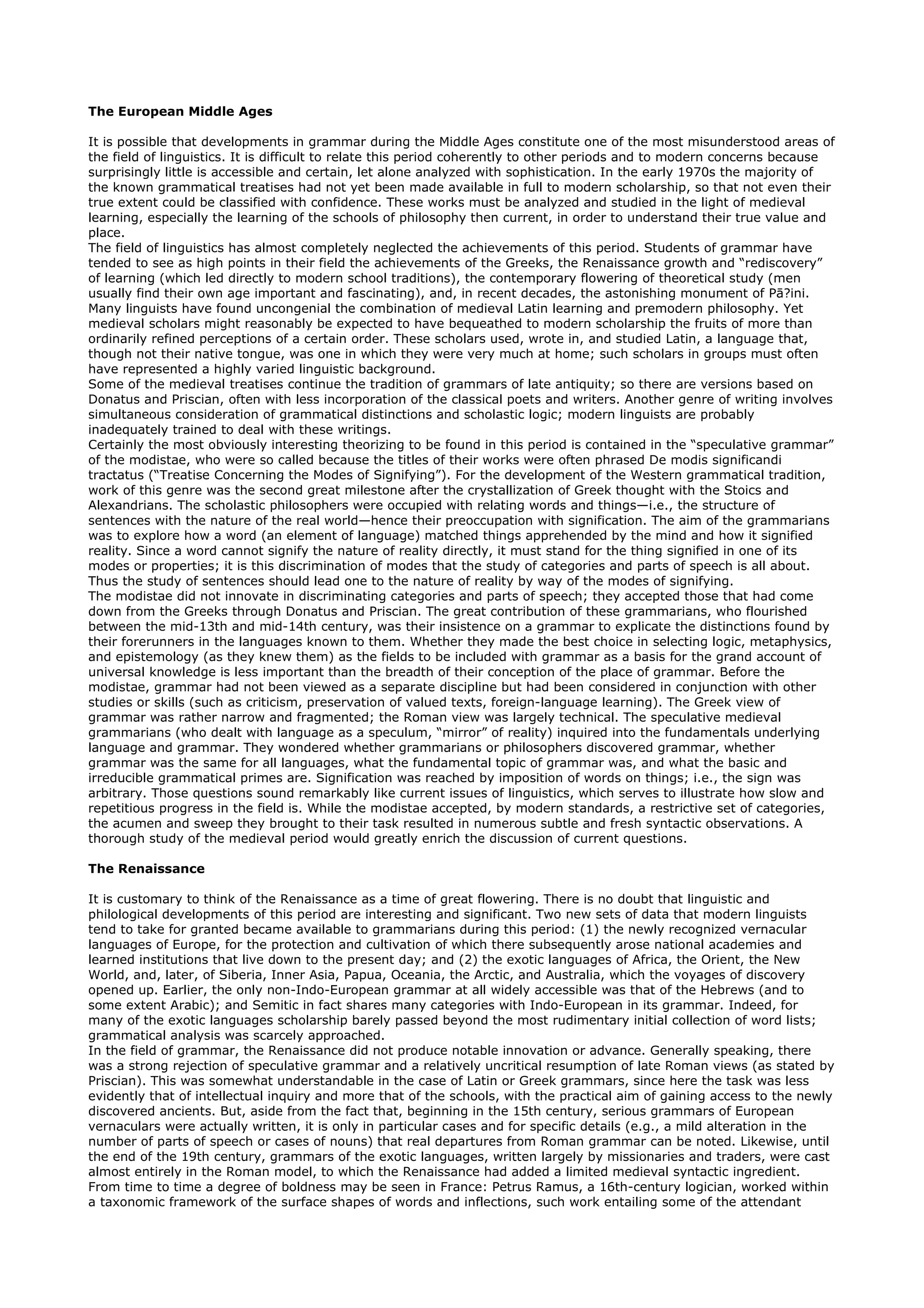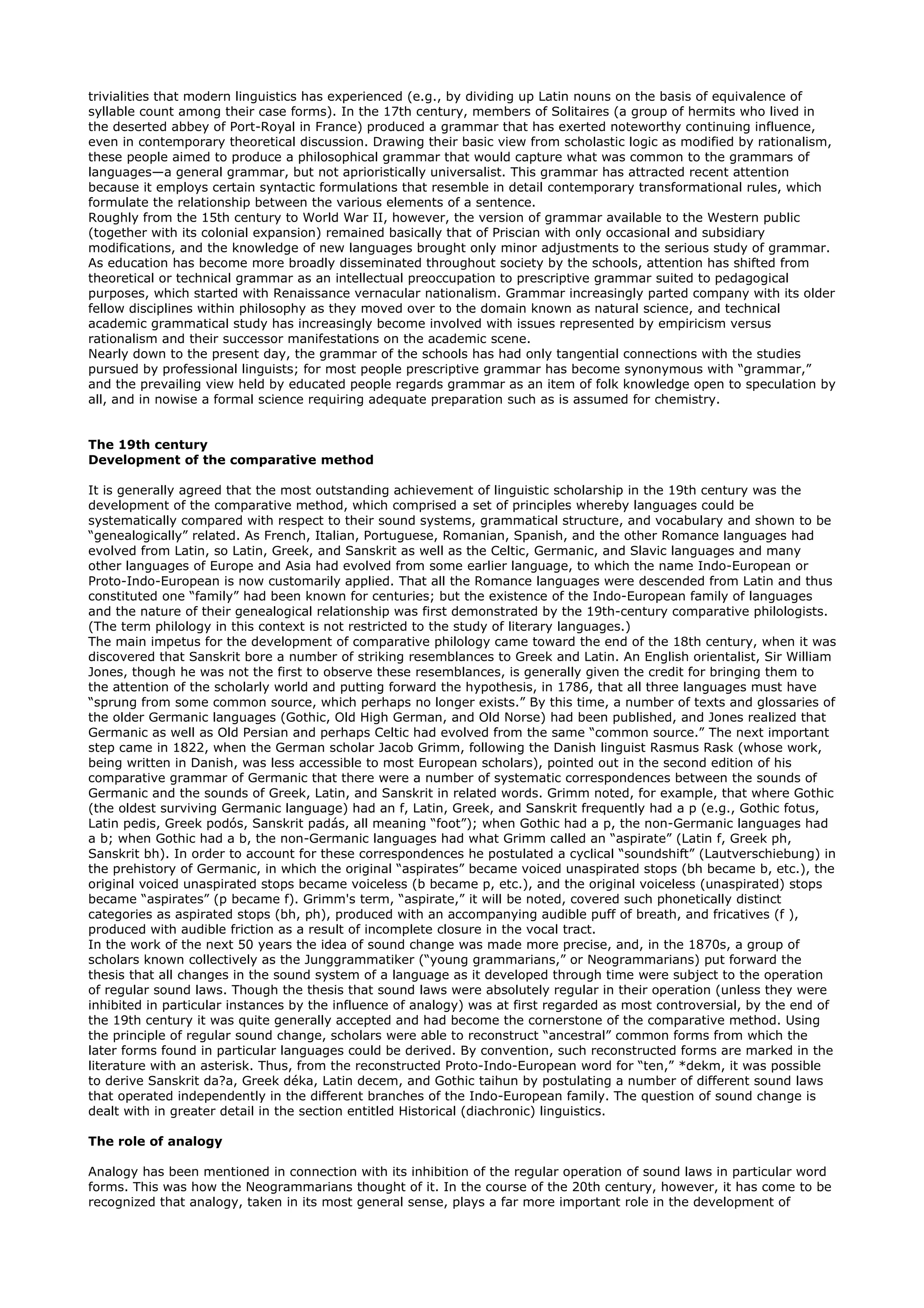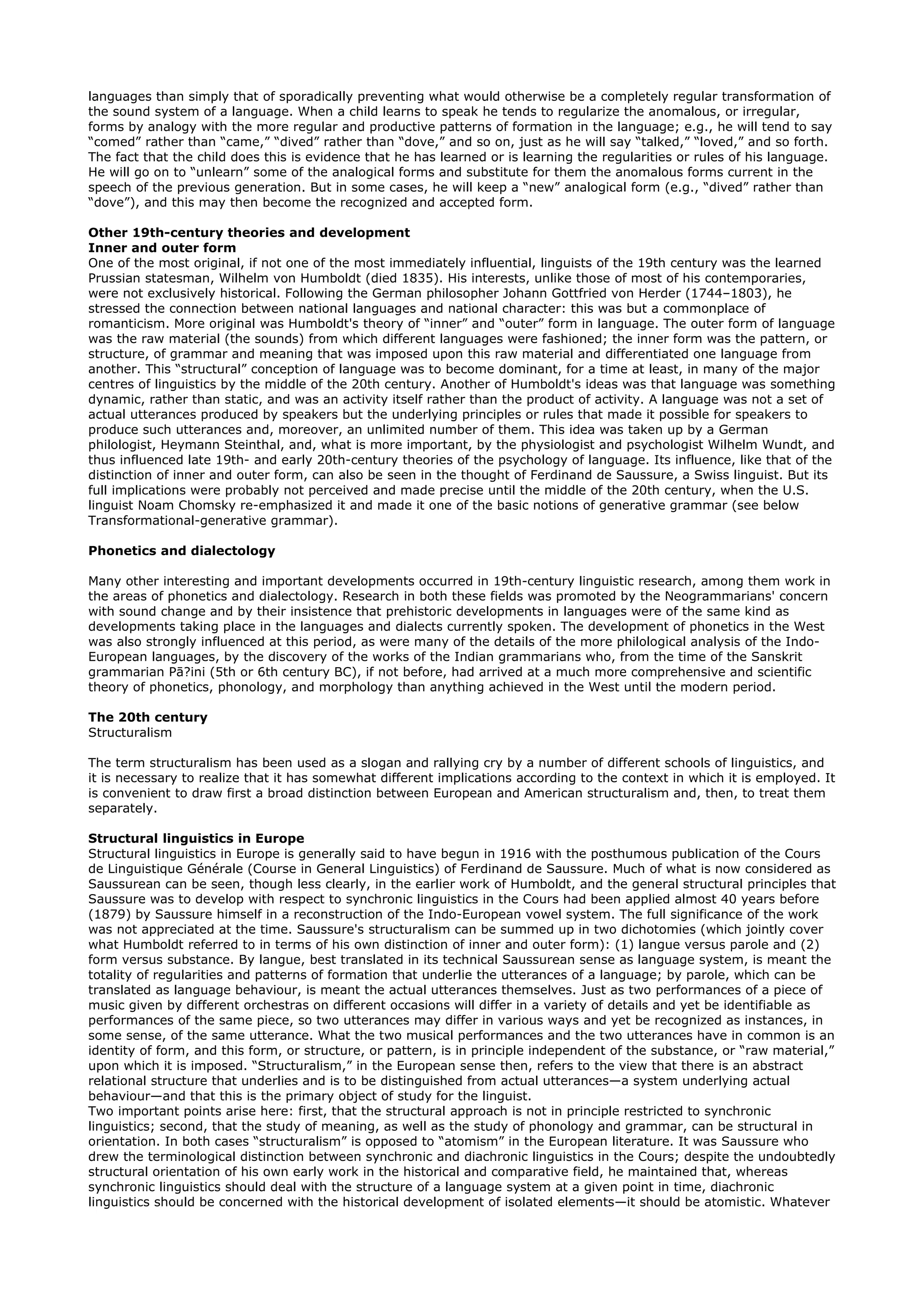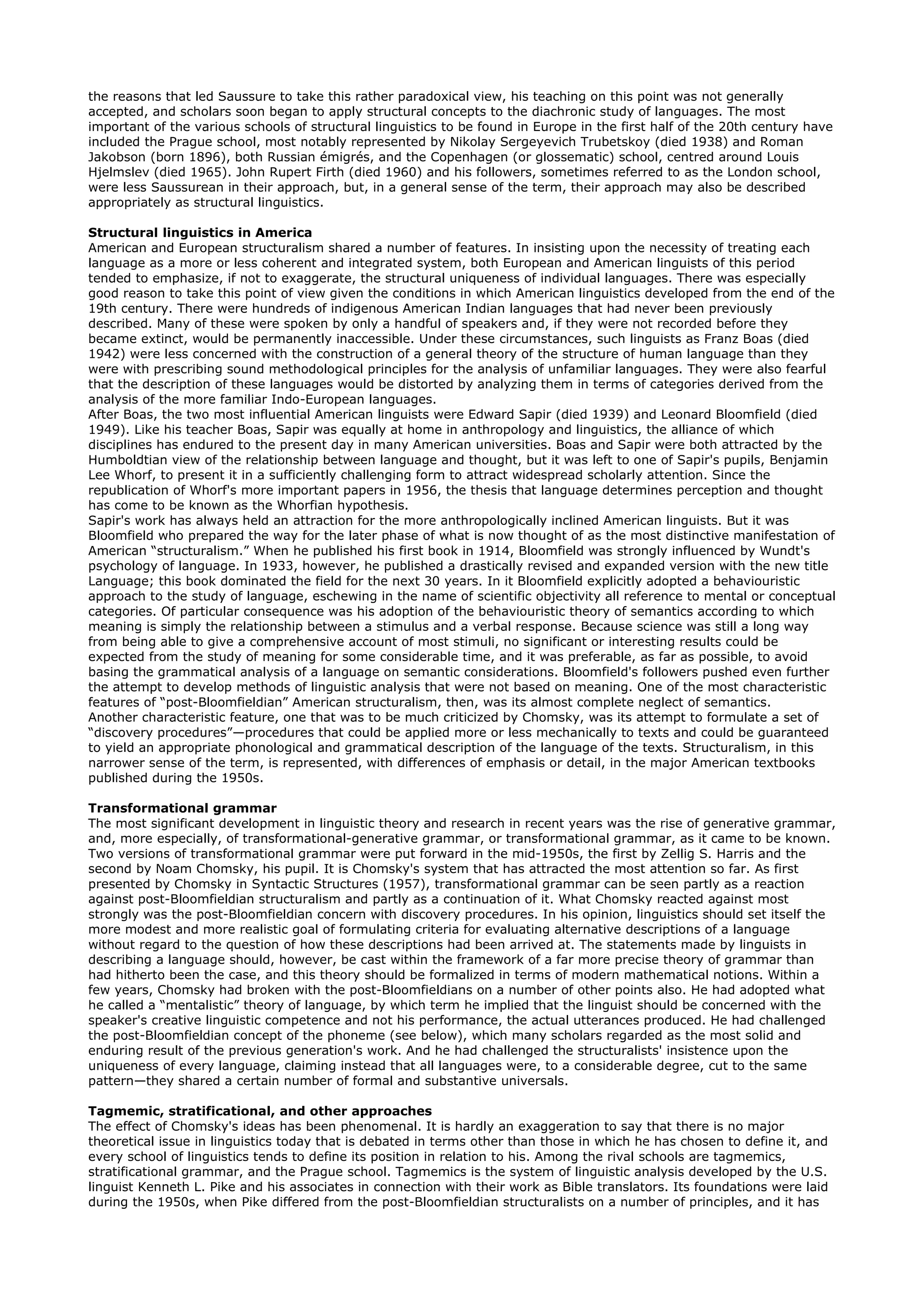This document provides a history of linguistics, beginning with non-Western traditions like those in Mesopotamia, China, and India. It discusses the grammatical tradition in India, particularly the work of Panini in the 5th century BC. It then covers the emergence of grammatical learning in Greece and its development by the Stoics, Alexandrians, Romans, and later scholars. It discusses speculative grammar during the European Middle Ages and developments during the Renaissance. Finally, it covers the major achievement of the 19th century - the development of the comparative method for relating languages genealogically.
![History of linguistics
Earlier history
Non-Western traditions
Linguistic speculation and investigation, insofar as is known, has gone on in only a small number of societies. To the
extent that Mesopotamian, Chinese, and Arabic learning dealt with grammar, their treatments were so enmeshed in
the particularities of those languages and so little known to the European world until recently that they have had
virtually no impact on Western linguistic tradition. Chinese linguistic and philological scholarship stretches back for
more than two millennia, but the interest of those scholars was concentrated largely on phonetics, writing, and
lexicography; their consideration of grammatical problems was bound up closely with the study of logic.
Certainly the most interesting non-Western grammatical tradition—and the most original and independent—is that of
India, which dates back at least two and one-half millennia and which culminates with the grammar of Pā?ini, of the
5th century BC. There are three major ways in which the Sanskrit tradition has had an impact on modern linguistic
scholarship. As soon as Sanskrit became known to the Western learned world the unravelling of comparative Indo-
European grammar ensued and the foundations were laid for the whole 19th-century edifice of comparative philology
and historical linguistics. But, for this, Sanskrit was simply a part of the data; Indian grammatical learning played
almost no direct part. Nineteenth-century workers, however, recognized that the native tradition of phonetics in
ancient India was vastly superior to Western knowledge; and this had important consequences for the growth of the
science of phonetics in the West. Thirdly, there is in the rules or definitions (sutras) of Pā?ini a remarkably subtle and
penetrating account of Sanskrit grammar. The construction of sentences, compound nouns, and the like is explained
through ordered rules operating on underlying structures in a manner strikingly similar in part to modes of
contemporary theory. As might be imagined, this perceptive Indian grammatical work has held great fascination for
20th-century theoretical linguists. A study of Indian logic in relation to Pā?inian grammar alongside Aristotelian and
Western logic in relation to Greek grammar and its successors could bring illuminating insights.
Whereas in ancient Chinese learning a separate field of study that might be called grammar scarcely took root, in
ancient India a sophisticated version of this discipline developed early alongside the other sciences. Even though the
study of Sanskrit grammar may originally have had the practical aim of keeping the sacred Vedic texts and their
commentaries pure and intact, the study of grammar in India in the 1st millennium BC had already become an
intellectual end in itself.
Greek and Roman antiquity
The emergence of grammatical learning in Greece is less clearly known than is sometimes implied, and the subject is
more complex than is often supposed; here only the main strands can be sampled. The term hē grammatikē technē
(“the art of letters”) had two senses. It meant the study of the values of the letters and of accentuation and prosody
and, in this sense, was an abstract intellectual discipline; and it also meant the skill of literacy and thus embraced
applied pedagogy. This side of what was to become “grammatical” learning was distinctly applied, particular, and less
exalted by comparison with other pursuits. Most of the developments associated with theoretical grammar grew out of
philosophy and criticism; and in these developments a repeated duality of themes crosses and intertwines.
Much of Greek philosophy was occupied with the distinction between that which exists “by nature” and that which
exists “by convention.” So in language it was natural to account for words and forms as ordained by nature (by
onomatopoeia—i.e., by imitation of natural sounds) or as arrived at arbitrarily by a social convention. This dispute
regarding the origin of language and meanings paved the way for the development of divergences between the views
of the “analogists,” who looked on language as possessing an essential regularity as a result of the symmetries that
convention can provide, and the views of the “anomalists,” who pointed to language's lack of regularity as one facet of
the inescapable irregularities of nature. The situation was more complex, however, than this statement would suggest.
For example, it seems that the anomalists among the Stoics credited the irrational quality of language precisely to the
claim that language did not exactly mirror nature. In any event, the anomalist tradition in the hands of the Stoics
brought grammar the benefit of their work in logic and rhetoric. This led to the distinction that, in modern theory, is
made with the terms signifiant (“what signifies”) and signifié (“what is signified”) or, somewhat differently and more
elaborately, with “expression” and “content”; and it laid the groundwork of modern theories of inflection, though by no
means with the exhaustiveness and fine-grained analysis reached by the Sanskrit grammarians.
The Alexandrians, who were analogists working largely on literary criticism and text philology, completed the
development of the classical Greek grammatical tradition. Dionysius Thrax, in the 2nd century BC, produced the first
systematic grammar of Western tradition; it dealt only with word morphology. The study of sentence syntax was to
wait for Apollonius Dyscolus, of the 2nd century AD. Dionysius called grammar “the acquaintance with [or observation
of] what is uttered by poets and writers,” using a word meaning a less general form of knowledge than what might be
called “science.” His typically Alexandrian literary goal is suggested by the headings in his work: pronunciation, poetic
figurative language, difficult words, true and inner meanings of words, exposition of form-classes, literary criticism.
Dionysius defined a sentence as a unit of sense or thought, but it is difficult to be sure of his precise meaning.
The Romans, who largely took over, with mild adaptations to their highly similar language, the total work of the
Greeks, are important not as originators but as transmitters. Aelius Donatus, of the 4th century AD, and Priscian, an
African of the 6th century, and their colleagues were slightly more systematic than their Greek models but were
essentially retrospective rather than original. Up to this point a field that was at times called ars grammatica was a
congeries of investigations, both theoretical and practical, drawn from the work and interests of literacy, scribeship,
logic, epistemology, rhetoric, textual philosophy, poetics, and literary criticism. Yet modern specialists in the field still
share their concerns and interests. The anomalists, who concentrated on surface irregularity and who looked then for
regularities deeper down (as the Stoics sought them in logic) bear a resemblance to contemporary scholars of the
transformationalist school. And the philological analogists with their regularizing surface segmentation show striking
kinship of spirit with the modern school of structural (or taxonomic or glossematic) grammatical theorists.](https://image.slidesharecdn.com/comprehensivehistoryoflinguistics-100630121641-phpapp01/75/Comprehensive-history-of-linguistics-1-2048.jpg)




